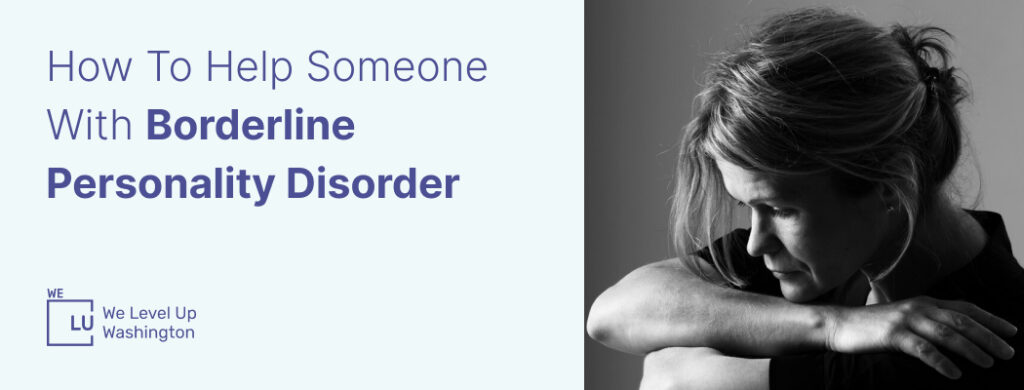BPD is a complex disorder that affects not only the person who has it but also others who are close to them. Caring for someone with the disease can be difficult for caregivers as well as close family members or friends, because of the emotional instability of Borderline Personality Disorder (BPD). You’re not the only one who may be uncertain about how to support someone with borderline personality disorder; it’s a common feeling.
The thing is, your support means everything. It won’t always be easy, and there will be days when you both feel overwhelmed. However, with the right support and resources, it is possible to build a stronger, more understanding connection with a loved one suffering from BPD. As you read on, you’ll find strategies and tips designed to enhance your ability to provide support and compassion – two things that We Level Up Washington knows BPD patients need plenty of!
Skip To:

What is borderline personality disorder?
Borderline personality disorder (BPD) is a complicated mental health illness characterized by emotional instability, difficulty maintaining relationships, and a distorted self-image. Individuals with BPD frequently experience strong episodes of anger, depression, and anxiety that can last from a few hours to several days!
However, that’s not all that’s plaguing individuals affected by this mental health condition. There are also:
- Extreme fear of abandonment or rejection.
- Unstable, often toxic, personal relationships.
- Impulsive and/or risky behaviors.
- Self-harming behavior and suicidal tendencies.
- Chronic sense of emptiness.
- Inappropriate, excessive anger, or difficulty controlling temper.
- Severe mood swings.
- Constant confusion about long-term goals, friendships, and values.
- Paranoid thoughts or dissociative symptoms under stress.
According to the National Institute of Mental Health, BPD affects approximately 1.6% of the adult population in the United States. Real numbers are probably much higher, as most cases aren’t officially diagnosed. BPD can occur in any age group, but it is most commonly diagnosed during adolescence.
This disorder appears to be more prevalent among women, with 75% of patients being female. However, recent research suggests this gender disparity may actually be caused by males feeling reluctant to seek help.
Get Help. Get Better. Get Your Life Back.
Searching for Accredited Dual Diagnosis Mental Health Centers Near You?
Even if therapy failed previously, or are in the middle of a difficult crisis, we stand ready to support you. Our trusted behavioral health specialists will not give up on you. When you feel ready or just want someone to speak to about counseling alternatives to change your life call us. Even if we cannot assist you, we will lead you to wherever you can get support. There is no obligation. Call our hotline today.
FREE 24/7 Dual Diagnosis Mental Health Services HotlineUnderstanding the causes and symptoms of BPD is the first step in learning how to support borderline personality disorder
While trying to learn how to help someone with borderline personality disorder, you may wonder how they came to be affected by the condition. Truth be told, more than one thing can contribute to it. Common belief is that genetic, environmental, and social factors all play a role in the development of BPD.
Research on the genetics of borderline personality disorder indicates a strong hereditary component. This means that individuals with a family history of BPD or other personality disorders are at higher risk of becoming affected by it. When it comes to environmental and social factors, early trauma, such as physical, sexual, or emotional abuse, neglect, or loss, may be to blame. These negative childhood experiences can disrupt the development of healthy emotional regulation and interpersonal skills.
When talking about triggers for the condition, we cannot but mention the fear of abandonment BPD patients often exhibit. This isn’t just about feeling nervous when someone you love is a bit late to call or text. It’s an intense, often overwhelming worry that those close to them might leave or stop caring, even over small misunderstandings or conflicts. This fear is deeply rooted in their emotions and can initiate a wide range of responses, from frantic efforts to avoid being alone to sudden anger or withdrawal in relationships.
While we have briefly touched upon the symptoms of the condition, they are best understood when grouped into four main BPD clusters.
- Emotional instability: People with BPD can experience emotions more deeply and changeably than others. One minute, they might feel okay, and the next, they might feel sad, angry, or scared without a clear reason. It’s like their feelings are in high volume all the time. Learning how to help BPD in crisis involves providing immediate support, understanding, and professional intervention when necessary.
- Interpersonal relationships: Imagine being terrified that the people you care about are going to leave you, even over small things. This fear can make relationships very intense and sometimes rocky for someone with BPD. They might think someone is perfect one day and then worry that the same person doesn’t care about them the next.
- Disturbed sense of self: A person with BPD might struggle with a persistent, unstable self-image or sense of identity. This can manifest as frequently changing their goals, beliefs, and aspirations or seeing themselves in extremes.
- Impulsivity and risky behavior: When emotions are overwhelming, someone with BPD might do things on a whim that could be risky or harmful, like spending too much money, driving too fast, or turning to substances. These actions are often attempts to deal with their pain. Responding with kindness rather than criticism and helping them find healthier ways to cope can be helpful here.
Breaking the symptoms of the condition into these four clusters makes it easier to understand. It can also help us approach our loved ones with the warmth and understanding they need. Everyone’s battle with BPD is personal, but having supportive, compassionate people who know how to support borderline personality disorder can make all the difference in going through the ups and downs. The question still remains, though: how to help someone with borderline personality disorder?

How to support partner with BPD?
When you’re there for someone with borderline personality disorder, you should arm yourself with kindness, patience, and really good listening skills. Work hard to create a space where they will feel seen and heard and have no fear of immediate judgment. This kind of supportive communication builds trust and makes them feel valued.
Active and empathetic listening is at the heart of this approach. You don’t have to do anything but simply be there, fully present, as they share their thoughts and feelings. Give them your full attention, nod, and say things like, “I hear you,” to let them know you’re truly listening. This can help lower the tension and make them feel more at ease.
Coupling this with the use of “I” statements helps to express your own needs and feelings without attributing blame. This is a perfect strategy for avoiding conflict escalation. For instance, saying, “I feel worried when you don’t answer your phone” instead of “You make me anxious when you ignore my calls,” can keep the conversation open and less defensive.
Equally important is the practice of validating emotions. This validation reassures the individual that their feelings are recognized and legitimate, even if the behaviors those feelings inspire need addressing.
Setting and maintaining healthy boundaries does not mean you don’t know how to support borderline personality disorder
Setting and keeping healthy boundaries is super important in any relationship, but it becomes even more important when learning how to help someone with borderline personality disorder. Boundaries are like guidelines or rules that help everyone know what’s okay and what’s not. They make relationships feel safer and more predictable for everyone involved.
Figuring out your own limits and talking about them in a kind and clear way can really cut down on confusion and hard feelings. Despite common belief, saying no to someone with BPD when setting boundaries isn’t something you should avoid! Instead, when it’s time to do it, do it from a place of empathy, but don’t forget to express yourself clearly while at it.
Knowing hot to help BDP in crisis is sticking to your boundaries consistently. It shows that you mean what you say and that you’re a steady presence in their life. This helps build trust and reinforces your relationship. It tells the person with BPD that they can rely on you, yet it also allows you to nurture your own well-being.

Self-care for supporters
Supporting someone with BPD can be pretty tough on you, making it paramount to take care of yourself, too. Truth be told, you need to be in a good place mentally and physically to be the best support you can be.
But how do you go about practicing self-care? This might mean getting some therapy for yourself, taking breaks when you need them, and doing things that make you happy. Keeping up with your hobbies and interests helps you recharge, so feel free to pick up that book you like reading, go for walks, or socialize. Also, getting enough sleep and eating well are basic but powerful ways to keep your energy up and your mind clear.
If you’re feeling a bit overwhelmed, joining a borderline personality disorder support group for loved ones of those struggling with the condition can be the right move. This can be that safe place you go to when you need to talk about what’s bothering you, get advice, and just feel understood. Also borderline personality disorder support groups offer a sense of community and remind you that you’re not alone in this journey. We Level Up Washington regularly holds family borderline personality disorder support group sessions which might be just what you need to take care of yourself and understand what your loved one is going through.
How to help someone with borderline personality disorder?
Truth be told, the best way to help someone struggling with BPD is to get them professional help beyond the kind of help borderline personality disorder support groups can offer. Our facility provides individuals grappling with borderline personality disorder with the resources they need to get better. One such resource is the dialectical behavior therapy (DBT). This form of therapy has shown promising results in the treatment of BPD. It’s meant to help those affected adopt healthy coping mechanisms needed to manage emotions, reduce self-destructive behaviors, and improve relationships.
While We Level Up Washington frequently uses DBT for bordeline personality disorder treatment, additional sets of therapies are widely adopted at our center. These include cognitive behavioral therapy (CBT), schema-focused therapy, and medication management. Of course, as no person is dealing with the exact same symptoms, we can’t talk about what approach will be taken when it comes to your loved one. We strongly believe in personalizing treatment to fit the scope of the problem and the individual dealing with it.
End the Emotional Pain. Get Your Life Back.
Feeling Depressed, Anxious or Struggling with Mental Health Illness? Get Safe Comfortable Mental Health Dual Diagnosis High-Quality Therapy From Counselors That Care. Begin Your Recovery Now.
Hotline: (509) 348-4077

Build trust and stability
Creating a stable and trustworthy environment is something that BPD patients warrant, as it helps reduce feelings of insecurity and fear of abandonment. Consistency and reliability can significantly impact your loved one’s sense of security and trust. This includes being dependable, following through on promises, and maintaining a routine that the person with BPD can rely on, both in a mental health facility and at home.
Engaging in positive activities together: how to support someone with borderline personality disorder
Participating in activities that both of you enjoy can significantly strengthen your relationship and promote positive emotional experiences following treatment. Engaging in shared hobbies and interests or simply spending quality time together can foster a sense of companionship and understanding. These activities provide healthy distractions from the stressors of daily life and BPD symptoms and offer opportunities for joy and relaxation.
Healthy distractions can also be a valuable tool in managing emotional stress and intense feelings. Activities such as exercise, art, mindfulness practices, or attending events can help divert attention from distressing thoughts or impulses.
How to help BPD in crisis patients?
When it comes to BPD and supporting those with it, you never really know what will happen next. You might find yourself in a crisis situation that requires immediate action, especially if your loved one is threatening to self-harm or take their own life. You must know what to do in these moments for their safety and yours.
You need to have a contingency plan ready, just in case it comes to this type of scenario. This means knowing whom to call, whether therapists or crisis hotlines and how to get in touch with emergency services if things get really serious. Writing down these numbers and keeping them handy can save you precious time when every second counts.
While being there for them is important, remember that you’ve also got to keep yourself safe. Sometimes, this might mean stepping back and letting professionals take over. It’s okay to do this. You’re not letting them down but simply doing what’s best for both of you.
First-class Facilities & Amenities
World-class High-Quality Mental Health Services & Behaviroal Health Substance Abuse Treatment
Rehab Centers TourRenowned Mental Health Centers. Serene Private Facilities. Inpatient Rehab Programs Vary.
Mental Health Helpline: (509) 348-4077Proven recovery success experience, backed by a Team w/ History of:
15+
Years of Unified Experience
100s
5-Star Reviews Across Our Centers
10K
Recovery Success Stories Across Our Network
- Low Patient to Therapist Ratio
- Comprehensive Dual-Diagnosis Treatment
- Complimentary Family & Alumni Programs
- Coaching, Recovery & Development Events
- Comfortable Onsite Medical Detox Center
Stigma and misconceptions
Even with all the research and knowledge we have today, BPD is often misunderstood. This leads to stigma and misconceptions that can isolate individuals and hinder their recovery. To counter this, we must work on educating ourselves and then others about BPD, its symptoms, and the experiences of those affected. Advocacy and open dialogue can help change perceptions and foster a more compassionate and informed society.
Also, it’s important to clarify the difference between BPD and similar disorders. It is common to be unsure whether BPD vs bipolar disorder is to blame for the questioning behavior, as both conditions are characterized by mood instability. However, they also have distinct causes, symptoms, and treatments. Educating others on how to support someone with borderline personality disorder can help dispel myths and provide individuals with a chance to receive the appropriate support and treatment.
Understanding complex cases
BPD often co-occurs with other mental health disorders, making treatment and support more complex but also necessary. When BPD coexists with disorders such as depression or anxiety, a dual diagnosis treatment in Washington State may be the best option, as it can address both conditions at once and shed more light on how to help BPD in crisis.

How to support borderline personality disorder and heal together
Life is anything but easy for those affected by borderline personality disorder. Their loved ones have it as hard since standing by those struggling requires a lot of heart, patience, and a willingness to learn how to help someone with borderline personality disorder the right way. Of course, there’s also the constant adapting to challenges that the condition throws your way. We Level Up Washington knows what you are going through, and we want to remind you that you’re not alone in this. There are effective ways to support someone with BPD, and with the right approach and our guidance, both you and your loved one can experience growth and positive change.
Sources:
- Amad, Ali, et al. “Genetics of Borderline Personality Disorder: Systematic Review and Proposal of an Integrative Model.” Neuroscience & Biobehavioral Reviews, vol. 40, Mar. 2014, pp. 6–19, https://doi.org/10.1016/j.neubiorev.2014.01.003.
- Bence, Sarah. “Is Borderline Personality Disorder Genetic?” Verywell Health, 6 Aug. 2021, www.verywellhealth.com/is-borderline-personality-disorder-genetic-5191970.
- “Borderline Personality Disorder.” Www.samhsa.gov, 8 Feb. 2023, www.samhsa.gov/mental-health/borderline-personality-disorder.
- “Borderline Personality Disorder.” Mental Health America, www.mhanational.org/conditions/borderline-personality-disorder.
- Leichsenring, Falk, et al. “Borderline Personality Disorder: A Comprehensive Review of Diagnosis and Clinical Presentation, Etiology, Treatment, and Current Controversies.” World Psychiatry: Official Journal of the World Psychiatric Association (WPA), vol. 23, no. 1, 1 Feb. 2024, pp. 4–25, pubmed.ncbi.nlm.nih.gov/38214629/, https://doi.org/10.1002/wps.21156.
- National Institute of Mental Health. “NIMH» Personality Disorders.” Www.nimh.nih.gov, 2003, www.nimh.nih.gov/health/statistics/personality-disorders.
World-class, Accredited, 5-Star Reviewed, Effective Mental Health Dual Diagnosis Programs. Complete Integrated Inpatient Rehab with Free Post Discharge Therapy Planning.
Hotline: (509) 348-4077End the Emotional Pain Rollercoaster. Gain Stability & Happiness Through Recovery Treatment. Start Mental Health Counseling Today. Get Free No-obligation Guidance by Behaviroal Health Specialists Who Understand Mental Health Recovery.
Experience Transformative Recovery at the We Level Up Treatment Center.
See our authentic success stories. Get inspired.
Get the help you deserve.



Start a New Life
Begin with a free call to a behavioral health treatment advisor. Learn more about our dual-diagnosis programs. The We Level Up treatment center network delivers recovery programs that vary by each treatment facility. Call to learn more.
- Personalized Care
- Caring Accountable Staff
- World-class Amenities
- Licensed & Accredited
- Renowned w/ 5-Star Reviews